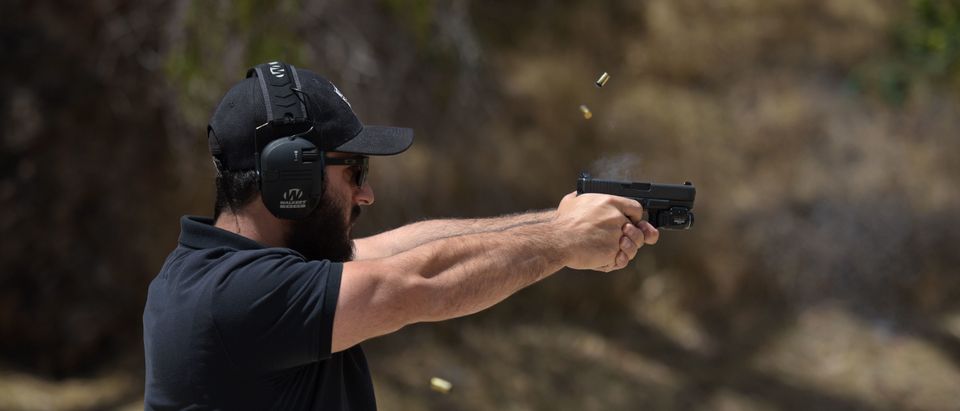By Sam Hoober, Alien Gear Holsters
Ever have issues where your point of aim is not quite your point of impact? It’s probably the gun’s fault.
Just kidding. It’s probably your fault, but it might be due to something that can get overlooked when it comes to use of handguns, namely the “hold” or the location on the target that the sights should be aligned on in order to get the hit you want.
If you’re using an incorrect hold, you’ll have point of aim/point of impact issues in terms of elevation. In other words, the group size is okay but it’s lower or higher on the target than you intended it to be.
Holding under the target, with your sights aligned under the (for the sake of discussion) bullseye, is called a 6 o’clock hold. Directly in the middle is center hold, and covering the target is usually called a 12 o’clock hold.
Which should you use? That depends on you and your gun.
The total beginner might not know this, but handguns sights have an inherent issue that doesn’t really get talked about much (but probably should) and it can have an effect on accuracy when it comes to POA/POI issues.
Most rifle sights, by contrast, don’t really have this problem since rifle sights – even cheesy iron sights from the 1950s – can be adjusted for windage and elevation and can be zeroed for just about any range the user desires.
Incidentally, this is an area in which red dots are better than iron sights as a sighting system, which we’ll circle back around to in a moment.
So, the hitch with iron sights is the height over bore, meaning the distance from the centerline in the middle of the barrel to the top of the handgun’s sights. The height over bore sets a point of aim/point of impact just like how the scope of a rifle (or iron sights) sets the distance (the zero) at which the point of aim intersects with the point of impact.
The bullet’s flight path, of course, is an arc, rising at first and then falling. The sights basically create an invisible line out to infinity. There’s a point at which the path of the bullet intersects that line. The distance at which that occurs depends on the height over bore of the sights as well as the caliber and load that you’re using; .357 Magnum doesn’t fall below zero until much further downrange than, say, .45 ACP.
However, what you’ll notice is absent from your handgun’s owner manual is any information at all about what that zero is, leaving it completely up to you to figure it out on your own.
Now, iron sights or a scope on a rifle can be adjusted for elevation, meaning any POA/POI can be resolved or reset in a manner beneficial to the shooter. A hunter, for instance, may want to set a maximum point blank range so their bullet lands within a specified area out to the furthest distance possible, maximizing the distance at which you don’t have to hold over. For instance, you can dial in a .30-06 rifle so the shot lands, say, no more than 4 inches above or below the point of aim out to about 300ish yards.
The iron sights of a pistol, however, can’t. So what the heck are you supposed to do?
Figure out if your height over bore sets impact high or low relative to your point of aim. Once you’ve done that, adjust your hold accordingly if you have to.
How do you go about doing that?
Start with a target with a defined target area, such as a bullseye target, and aim for the center of the bullseye. You’ll need to shoot a group, let’s say 5 shots, at each hold. You can start with a 6 o’clock hold (sights under the target), then another group holding center (sights directly aligned with the target) and then another group at a 12 o’clock hold.
A best practice would be to shoot from a rest if possible, to remove as much shooter error from the equation as you can.
What you’re looking for is a correlation between where you’re holding (and therefore your point of aim) and your point of impact. It’s also a good idea to repeat it at various ranges, such as in 5-yard increments and also note if anything changes, such as if a 6 o’clock hold is hitting low at 5 yards but is spot on at 25 yards. That would indicate the height over bore zeroes the sights to 25 yards and therefore you’ll want to hold the center at close range and then shift as you get further out.
So, you might not be hitting the target in the spot you want using the hold you typically use because of your sights. If, that is, you’re doing your job as a pistol shooter; recoil anticipation and other issues are a more common cause of not hitting the target than using the incorrect hold for your sights, but with that said this is an aspect of shooting a handgun with iron sights that gets overlooked.
Pistol sights are terrifically imprecise compared to rifle sights even of the mid 20th century, which is one reason why red dots really are technically superior given the adjustability. With that said, once you understand what iron sights do (and also their limitations) you can learn how to get a bit more out of them.
Click here to get your 1911 Pistol Shopping Guide.
Click here to get The Complete Concealed Carry Training Guide
Sam Hoober is a Contributing Editor to AlienGearHolsters.com, a subsidiary of Hayden, ID, based Tedder Industries, where he writes about gun accessories, gun safety, open and concealed carry tips. Click here to visit aliengearholsters.com.


